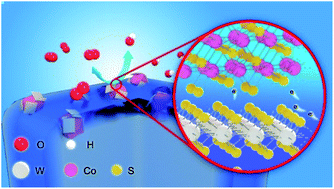Heterostructuring cobalt sulfide with highly oxophilic 1T-tungsten sulfide for durable and efficient oxygen electrocatalysis†
Abstract
First-row transition metal sulfides are one of the most promising platinum-group metal-free catalysts toward oxygen electrocatalysis, but their structural and compositional changes during catalysis result in the instability of the electrochemical performance. Herein, a heterointerface strategy is proposed for constructing 1T-phase tungsten sulfide decorated on cobalt sulfide for modulating the electronic structure and retarding the phase change of the underlying cobalt sulfide due to the high oxophilicity and strong electronic interaction, as well as the metallic feature. Consequently, an impressive electrocatalytic performance toward oxygen reduction is achieved with a comparable mass activity to platinum-group metals and no noticeable degradation regardless of what is performed in the rotating-disk electrode and gas diffusion electrode setups. Moreover, the turnover frequency is almost one order of magnitude higher than that of cobalt sulfide for catalyzing oxygen evolution. When employed as the cathode of a zinc–air battery, it delivers an improved cycling performance over 480 h of operation and a peak power density of 183.5 mW cm−2, outperforming most transition metal sulfides reported to date. This work provides an effective strategy to improve the activity and durability of first-row transition metal sulfides by interface engineering for oxygen electrocatalysis.

- This article is part of the themed collection: Journal of Materials Chemistry A Emerging Investigators


 Please wait while we load your content...
Please wait while we load your content...